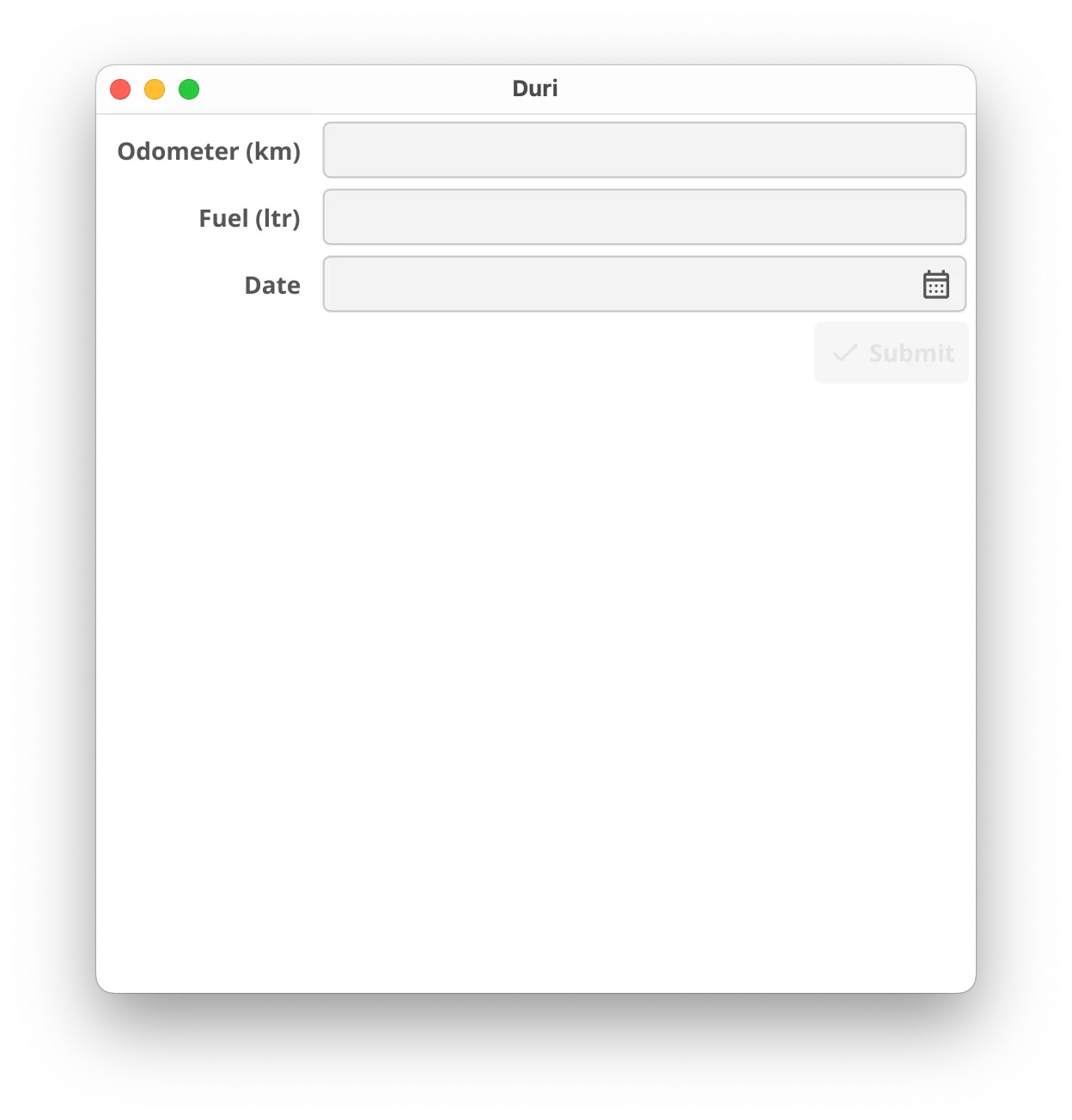Let’s build our fuel log input page!
For setup, go here: Part 1
First, what data actually goes into a fuel log? Just 3 values, per our design spec: Distance, Volume and Time
Now, back to the main show in main.go file.
Fyne has something called an Entry widget that are equivalent of form inputs. And there is the eponymous Form that is, quoting the docs, “…used to lay out many input fields with labels and optional cancel and submit buttons”.
So, let’s go add our 3 inputs into a form:
odoInput := widget.NewEntry()
fuelInput := widget.NewEntry()
dateInput := &widget.DateEntry{}
form := &widget.Form{
Items: []*widget.FormItem{
{Text: "Odometer (km)", Widget: odoInput},
{Text: "Fuel (ltr)", Widget: fuelInput},
{Text: "Date", Widget: dateInput},
}While we’re at it, let’s increase the size of our window to accommodate all stuff with w.Resize(fyne.NewSize(512, 512)).
Where are we processing the input, ye ask? Good question. form widget has an onSubmit hook that we can attach our function to. Let’s add a simple log for now:
package main
import (
"log"
"fyne.io/fyne/v2"
"fyne.io/fyne/v2/app"
"fyne.io/fyne/v2/widget"
)
func main() {
a := app.New()
w := a.NewWindow("Duri")
odoInput := widget.NewEntry()
fuelInput := widget.NewEntry()
dateInput := &widget.DateEntry{}
form := &widget.Form{
Items: []*widget.FormItem{
{Text: "Odometer (km)", Widget: odoInput},
{Text: "Fuel (ltr)", Widget: fuelInput},
{Text: "Date", Widget: dateInput},
},
OnSubmit: func() {
log.Println("Form submitted:", odoInput.Text, fuelInput.Text, dateInput.Text)
},
}
w.Resize(fyne.NewSize(512, 512))
w.SetContent(form)
w.ShowAndRun()
}Go ahead and
go run .Do you see a nice window with out 3 inputs?

Try adding some values and click submit. Then check the logs. Should show something like:
2025/11/02 20:08:30 Form submitted: 1000 35.6 11/11/2025Ah, but we aren’t actually saving the values anywhere yet! Before we do that, let’s create a structure for our fuel logs, then parse the strings we get from the form and create a new struct from them:
We’ll define our struct like so (just above the main function):
type FuelLog struct {
odometer int
fuel float64
date time.Time
}And back onSubmit, we parse our values like so:
OnSubmit: func() {
log.Println("Form submitted:", odoInput.Text, fuelInput.Text, dateInput.Text)
odometer, err := strconv.Atoi(odoInput.Text)
if err != nil {
panic(err)
}
fuel, err := strconv.ParseFloat(fuelInput.Text, 64)
if err != nil {
panic(err)
}
date, err := time.Parse("02/01/2006", dateInput.Text)
if err != nil {
panic(err)
}
fl := FuelLog{odometer, fuel, date}
log.Println(fl)
},And go run again, input, submit, and check the logs. Do you see a…
2025/11/02 20:13:10 {1003 123.1 {0 63899193600 <nil>}}…just below the previous log? That’s our struct right there.
Check out this link of the exact code at this commit: f70c60b
And thus concludes the bite-sized part-2. See ya in part-3!
Update: Next section is up here on Part 3